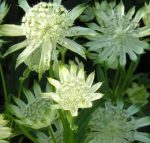 Popular in Britain but little known in the US, greater masterwort is a stoloniferous herbaceous perennial native to central and eastern Europe where it grows in mountain meadows, grasslands, woodland clearings, and moist areas near streams. It a member of the carrot family, Apiaceae, that also includes parsely, celery, and Queen Anne’s lace. Plants have a 18″tall basal clump of toothed ark green leaves 3-6″ long that are palmately divided to have 3-5 lobes. Almost leafless 24″ stems have leaves with wide petioles that clasp the stems and bear flowerheads in late spring to early summer. The flowerheads are 2-3″ across and are made up of doomed umbels of tiny white to pink flowers surrounded by showy petal-like creamy white bracts. Flowers have a long vase life of 10-14 days and dry especially well. Plant do not tolerate drying out and do best in cool climates with summer night time temperatures below 70 F. In optimal sites the plants will spread and can be divided. The genus name, Astrantia may come from the Greek word astron meaning star in referring to the shape of the flowerhead. Alternately, it may come from the Latin word magister meaning master or teacher. The specific epithet is the Latin word meaning bigger or larger.
Popular in Britain but little known in the US, greater masterwort is a stoloniferous herbaceous perennial native to central and eastern Europe where it grows in mountain meadows, grasslands, woodland clearings, and moist areas near streams. It a member of the carrot family, Apiaceae, that also includes parsely, celery, and Queen Anne’s lace. Plants have a 18″tall basal clump of toothed ark green leaves 3-6″ long that are palmately divided to have 3-5 lobes. Almost leafless 24″ stems have leaves with wide petioles that clasp the stems and bear flowerheads in late spring to early summer. The flowerheads are 2-3″ across and are made up of doomed umbels of tiny white to pink flowers surrounded by showy petal-like creamy white bracts. Flowers have a long vase life of 10-14 days and dry especially well. Plant do not tolerate drying out and do best in cool climates with summer night time temperatures below 70 F. In optimal sites the plants will spread and can be divided. The genus name, Astrantia may come from the Greek word astron meaning star in referring to the shape of the flowerhead. Alternately, it may come from the Latin word magister meaning master or teacher. The specific epithet is the Latin word meaning bigger or larger.
Type: Herbaceous perennial
Bloom: Small white or pink flowers are borne late spring to early summer in dense umbels surrounded by colored bracts; flower heads are 2-3″ across, with good bloom time and vase life.
Foliage: Basal toothed leaves and have 3-5 lobes; leaves on stem have wide petioles which clasp the stem.
Size: 2-3′ H x 1.5′ W
Light: Part shade
Soil: Organically rich, moist, well-drained; must never dry out
Hardiness: Zones 4-7
Care: Deadhead to prevent unwanted reseeding (may not be true to color)
Pests and Diseases: None of significance
Propagation: Division of roots in autumn or early spring; spreads by runners to form good sized clumps.
Companion plants: Astilbe, hosta, fringed bleeding heart, ferns
Outstanding Selections:
‘Shaggy’ (extra long collar of pink bracts)
‘Sunningdale Variegated’ (Light green leaves splashed with yellow and cream)
